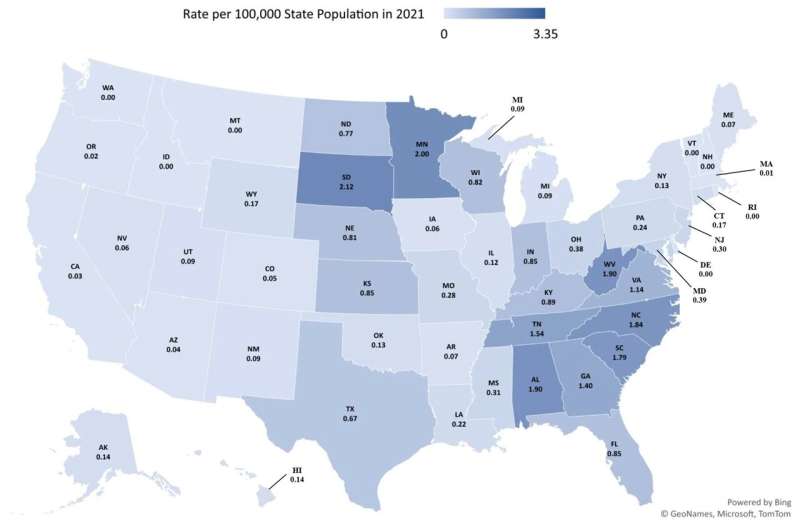This article has been reviewed according to Science X's editorial process and policies. Editors have highlighted the following attributes while ensuring the content's credibility:
fact-checked
peer-reviewed publication
trusted source
proofread
Study finds increase in exposures to delta-8 THC among young children, teens, and adults

A new study examining trends in calls to poison centers across the country for exposures to delta-8 tetrahydrocannabinol (THC), conducted by researchers at the Center for Injury Research and Policy of the Abigail Wexner Research Institute at Nationwide Children's Hospital and the Central Ohio Poison Center, shows a sharp rise in exposures, including among children, and variation among states and regions.
The study, published in the Journal of Medical Toxicology, found that the rate of delta-8 THC exposures reported to poison centers across the country increased by nearly 80% from January 1, 2021 to December 31, 2022, with the U.S. South accounting for more than two-thirds of exposures.
The rate of delta-8 THC exposures reported to poison centers was significantly lower among states where delta-8 THC was banned and among states where cannabis use was legal. Products containing delta-8 THC are often referred to as "diet weed" or "hemp products," which leads to a misperception that they are safer alternatives to the more regulated and more abundant delta-9 THC.
"All cannabis products, including delta-8 THC, can be extremely toxic for young children. Children represented more than half of exposures in this study, with nearly 1 in 3 exposures being children younger than 6 years. Children younger than 6 accounted for half of non-critical care unit admissions and 58 percent of critical care admissions," said Hannah Hays, MD, co-author of the study, medical director of the Central Ohio Poison Center and faculty of the Center for Injury Research and Policy at Nationwide Children's.
Safe storage
This rise in exposures highlights the importance of education around increased risks for children and the importance of safe storage and packaging, according to pediatricians and researchers at Nationwide Children's and the Central Ohio Poison Center.
"If someone vapes, smokes, eats edibles or drinks infused beverages with delta-8, those products should be stored up, away, and out of sight and reach of children, preferably in a locked container," Hays said. "These products should never be used in front of kids who might mistake them for food or drinks that they are allowed to have."
Other recommendations for parents/guardians and caregivers:
- Talk to children about cannabis-related products. Have age-appropriate conversations with children about cannabis-related products, explaining what these products are and why they can be dangerous.
- Store cannabis-related products safely. The best way to keep children safe from cannabis-related products is to keep them out of the home. If these products are kept in the home, store them in a safe place away from your children—stored up and out of sight, away from food, and locked if possible. Ask that caregivers around your child do the same in their homes.
- Don't use these products in front of children. It is helpful to never use these products in front of your children, especially if packaged to look like treats.
- Save the national Poison Help Line number (1-800-222-1222) in your phone and post it in a visible place in your home. The Poison Help Line provides free, confidential advice from experts, 24 hours per day, seven days per week.
Safe packaging
Study investigators also highlight inconsistent regulations of these products from state to state. Because the U.S. Food and Drug Administration currently does not regulate the manufacturing of these products, contaminants such as heavy metals, solvents or pesticides may be found in them and may not be listed on product packaging.
In addition, in many states, delta-8 THC products may not have the packaging or labeling requirements that delta-9 THC products have.
"The differences in state regulations have led to an environment that allows for easily available products that may have unlisted contaminants, inaccurate labels and packaging that may entice children," said Christopher Gaw, MD, co-author of the study, pediatric emergency medicine physician and faculty member of the Center for Injury Research and Policy at Nationwide Children's. "We need clearer regulation of these products with better oversight and enforcement."
More information: Gary A. Smith et al, Delta-8 Tetrahydrocannabinol Exposures Reported to US Poison Centers: Variations Among US States and Regions and Associations with Public Policy, Journal of Medical Toxicology (2024). DOI: 10.1007/s13181-024-01030-z



















